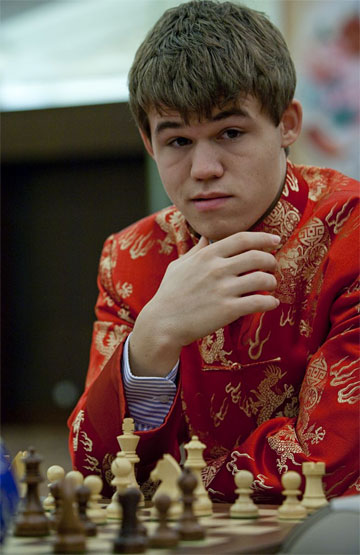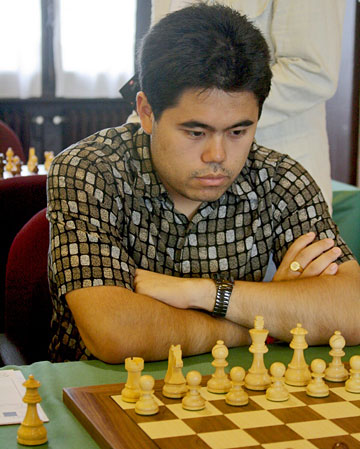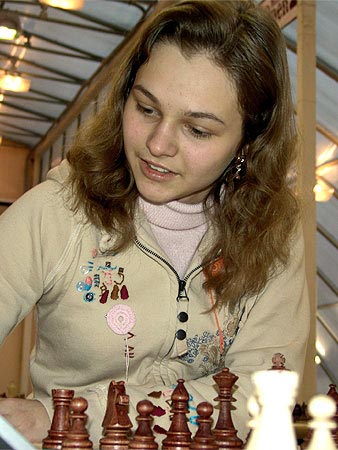| Latest | Greatest | Lobby | Journals | Search | Options | Help | Login |
|
|
|
This topic is archived. |
| Home » Discuss » Topic Forums » Sports |
|
| Jack Rabbit
|
Sun Jan-31-10 05:15 PM Original message |
| The JR Chess Report (January 31): Magnus Wins in Wijk |
|
Magnus Survives Loss to Kramnik, Wins Wijk
 Norwegian grandmaster Magnus Carlsen survived a ninth-round defeat at the hands of former world champion Vladimir Kramnik of Russia to win the Group A competition at the Dutch North Sea resort of Wijk ann Zee, which completed earlier today. The result put Kramnik in first place after nine rounds, where he remained until reigning world champion Vishy Anand defeated him in yesterday's twelfth round. Meanwhile, Magnus, showing the character of a champion, simply dusted himself off and won his next two games to recapture first place yesterday. Most games in Group A were drawn today, with the only decisive outcome being reigning US national champion Hikaru Nakamura over two-time Dutch national champion Sergei Tiviakov. By winning the game, Nakamura finished tied for fourth with Anand. To win the event, Magnus scored 8½ points (+5 -1 =7) to finsish a half-point ahead of Kramnik and Latvian-born Spanish grandmaster Alexei Shirov, who began the tournament by winning five games in a row but made little impact afterward. Group B was won by Dutch national champion Anish Giri, 15, with 9 points, a half-point point over Latvian-born German grandmaster Arkadij Naiditsch. Chinese grandmaster Li Chao won Group C handily with 10 points, a point and a half ahead of former world junior champion Abhijeet Gupta of India. Fifteen-year-old American GM Ray Robson, who lead in the early going, finished tied for fifth with 7½ points. Gibraltar Underway; Four-Way Tie for First after Six  The eighth annual Gibtelecom Masters' Open began in Gibraltar Tuesday at the Caleta Hotel on The Rock. After six rounds, four players are tied for first place with 5 points each. They are: grandmaster Mickey Adams of Britain; German GM Jan Gustafsson; Chandra Sandipan of India; and Ukrainian WGM Natalia Zhukova, the wife of reigning Russian national champion Alexander Grischuk. In tomorrow's pairings, Ms. Zhukova will have White against Adams and Sandipan will play White against Gufstaffson. The ten round tournament concludes Thursday. The games begin at 3 pm local time (6 am PST) and live games will be broadcast on the Official Tournament Website. Moscow Open Begins  The annual Moscow open began yesterday with 187 participants in the main tournament and 140 in the women's tournament. Neither the main nor the women's tournament feature last year's winners, US grandmaster Alex Onischuk and Russian WGM Natalia Pogonina. Natalia Andreevna started the Russian women's championship tournament in December and had to dop out after seven rounds due to illness. After two rounds, 20 palyers have perfect scores including top seeded Russian GM Alexander Motylev and fifteen-year-old Chinese GM Hou Yifan, making her return to international chess after an absense of several weeks. In the women's tournament, 28 players have won both their games including the top seed, Chinese WGM Ju Wenjun and German IM Elisabeth Pähtz. The Moscow Open is a nine-round Swiss System event running through next Sunday. The top boards of the main and women's tournament are broadast live at the official tournament website beginning at 4 pm local time (5 am PST). Calendar Bundesliga 0910, Rounds 7-9, Munich, Mülheim, Berlin, Ramagen. 5-7 February. Aeroflot Open, Moscow 9-17 February. 27th Ciudad de Linares 12-25 February. Aronian, Gashimov, Gelfand, Grischuk, Topalov and Vallejo. Reykjavik Open 24 February-3 March. Bundesliga 0910, Rounds 10-11, Mülheim, Heidelburg, Solingen, Trier. 27-28 February. European Individual Championships, Rijeka (Croatia) 5-19 March. Melody Amber Rapid/Blindfold Tournament, Nice. 12-25 March. Aronian, Carlsen, Domínguez, Gelfand, Gashimov, Ivanchuk, Karjakin, Kramnik, Morozevich, Ponomariov, Smeets and Svidler. Philadelphia Open 31 March-4 April. This replaces the Foxwoods Open after the Foxwoods Resort announced expected room rate hikes. Russian Team Championships, Dagomys 1-12 April. Women's Grand Prix, Nalchik 23 April-6 May. Anand-Topalov Match for the World Title, Sofia 23 April-10 May. Grand Prix, Astrakhan (Russia) 9-25 May. US Championship, St. Louis 13-25 May. Chicago Open 27-31 May. Women's Grand Prix, Jermuk 23 June-6 July. World Open, Valley Forge, Pennsylvania 29 June-5 July. Women's Grand Prix, Ulan Bator (Mongolia) 29 July-12 August. World Junior Championships, Chotowa Czarna (Poland) 2-17 August. Chess Olympiad, Khanty Mansiysk 19 September-4 October. European Club Cup, Plovdiv 16-24 October. Women's Grand Prix, Vina del Mar (Chile) 27 October-9 November. World Youth Championships, Halidiki (Greece) 19-31 October. FIDE Women's Knock Out (Women's World Championship), Turkey 2-25 December. |
| Printer Friendly | Permalink | | Top |
| Jack Rabbit
|
Sun Jan-31-10 05:19 PM Response to Original message |
| 1. This week's games |
|
Your humble hare acknowledges the assistance of Fritz 6.0 on analysis. Diagrams on the Jack Rabbit Chess Report are made with Chess Mérida, a true type font that can be downloaded free here. !""""""""# $tMvWlVmT% $OoOoOoOo% $ + + + +% $+ + + + % $ + + + +% $+ + + + % $pPpPpPpP% $RnBqKbNr% /(((((((() WHITE White to move (This position is a theoretical draw) I would like to thank my impressive and loyal staff: Buccaneer, Spitfire, Swashbuckler, Pancho and Robin Hood. |
| Printer Friendly | Permalink | | Top |
| Jack Rabbit
|
Sun Jan-31-10 05:23 PM Response to Reply #1 |
| 2. 72nd Corus Chess Tournament, Wijk aan Zee |
| Printer Friendly | Permalink | | Top |
| Jack Rabbit
|
Sun Jan-31-10 05:27 PM Response to Reply #2 |
| 4. Karjakin - Carlsen, Round 8 |
 Magnus Carlsen Sergey Karjakin - Magnus Carlsen 72nd Corus Tournament (Group A), Round 10 Wijk aan Zee, 27 January 2010 Closed French Game: Steinitz Opening 1.e4 e6 2.d4 d5 3.Nc3 Nf6 4.e5 Nfd7 5.f4 c5 6.Nf3 Nc6 7.Be3 Be7
8.Qd2 0-0 9.Be2
9...a6 10.0-0 b5 11.Kh1
11...Qc7!?
12.a3
12...Bb7 13.Rad1 Rac8
14.Qe1
14...cxd4 15.Nxd4 Nxd4 16.Bxd4 Bc5
17.Qh4
17...Bxd4 18.Rxd4 f6
19.Bd3
19...h6 20.exf6 Rxf6 21.f5?
!""""""""# $ +t+ +l+% $+vWm+ O % $o+ +oT O% $+o+o+ + % $ + R + Q% $P Mb+ + % $ Pp+ +pP% $+ + +r+k% /(((((((() WHITE: Sergey Karjakin Position after 21.f4f5 21...Rcf8
22.Rg1 Nc5 23.fxe6 Nxe6
24.Rg4
24...Nf4!
25.Qg3 Qe7 26.Rxf4
26...Rxf4 27.Ne2 !""""""""# $ + + Tl+% $+v+ W O % $o+ + + O% $+o+o+ + % $ + + T +% $P +b+ Q % $ Pp+n+pP% $+ + + Rk% /(((((((() WHITE: Sergey Karjakin Position after 27.Nc3e2 27...Rf1!
28.Nd4
28...Rxg1+ 29.Kxg1 Re8 30.h4
30...Qe1+ 31.Kh2 Qxg3+ 32.Kxg3 Kf7 33.Kf2
!""""""""# $ + +t+ +% $+v+ +lO % $o+ + + O% $+o+o+ + % $ + N + P% $P +b+ + % $ Pp+ Kp+% $+ + + + % /(((((((() WHITE: Sergey Karjakin Position after 33.Kg3f2 33...Kf6
34.g3 Bc8 35.c3 Bg4 36.Bc2 g5
37.hxg5+ hxg5 38.Bb3 Ke5
39.Bc2 Rf8+ 40.Kg2 Bd7 41.Nf3+ Kf6 42.Bb3
42...g4 43.Nd4 Ke5 44.Bc2 a5 45.Bd1 Ke4 0-1
|
| Printer Friendly | Permalink | | Top |
| Jack Rabbit
|
Sun Jan-31-10 05:29 PM Response to Reply #2 |
| 5. Kramnik -Nakamura, Round 8 |
 Vladimir Kramnik Vladimir Kramnik - Hikaru Nakamura 72nd Corus Tournament (Group A), Round 8 Wijk aan Zee, 24 January 2010 Hollander Game: Leningrad Defense 1.d4 f5 2.g3 Nf6 3.Bg2 g6
4.c4 Bg7 5.Nc3 0-0 6.Nf3 d6 7.0-0 c6
8.Rb1
8...Ne4
9.Qc2!?
9...Nxc3
10.bxc3 e5 11.Rd1 e4 12.Ng5 h6
13.Nh3 g5
14.f3 d5 15.Nf2 Kh8!?
16.cxd5 cxd5 17.c4!?
!""""""""# $tMvW T L% $+ + + V % $ + + + O% $+ +o+oO % $ +pPo+ +% $+ + +pP % $p+q+pNbP% $+rBr+ K % /(((((((() WHITE: Vladimir Kramnik Position after 17.c3c4 17...e3!?
18.Nd3!
18...Nc6
19.Bxe3!
19...Nxd4 20.Bxd4 Bxd4+
21.Kh1
21...f4!?
22.Rb5!
22...Qf6?
!""""""""# $t+v+ T L% $Oo+ + + % $ + + W O% $+r+o+ O % $ +pV O +% $+ +n+pP % $p+q+p+bP% $+ +r+ +k% /(((((((() WHITE: Vladimir Kramnik Position after 22...Qd8f6 23.Rxd5
23...Be6
24.Nxf4 gxf4 25.R5xd4 fxg3 26.hxg3
26...Rg8 27.Rf4 Qg5 28.Rh4 Rg6 29.Qc3+ Kh7
!""""""""# $t+ + + +% $Oo+ + +l% $ + +v+tO% $+ + + W % $ +p+ + r% $+ Q +pP % $p+ +p+b+% $+ +r+ +k% /(((((((() WHITE: Vladimir Kramnik Position after 29...Kh8h7 30.f4!
30...Qxg3 31.Qxg3 Rxg3 32.Bxb7 Rb8 33.Be4+ Kg7 34.Kh2 Re3
35.Rg1+ Kf7 36.Bg6+ Ke7 37.Bd3 Rb2 38.Rg2 Rxa2
39.Rxh6 Bf7 40.Rh7 Kf6
41.c5 Ra4 42.c6 Rxf4 43.c7 Re8 44.Rxf7+ 1-0
|
| Printer Friendly | Permalink | | Top |
| Jack Rabbit
|
Sun Jan-31-10 05:30 PM Response to Reply #2 |
| 6. Swinkels - Li Chao, Round 10 |
 Li Chao Robin Swinkels - Li Chao 72nd Corus Tournament (Group C), Round 10 Wijk aan Zee, 27 January 2010 King's Engslish Game: Catalan Four Knights' Opening 1.c4 Nf6 2.g3 e5 3.Bg2 d5 4.cxd5 Nxd5 5.Nc3 Nb6 6.Nf3 Nc6 7.0-0 Be7 8.a3 0-0
9.b4 Be6 10.Rb1 f6 11.d3 a5
12.b5 Nd4 13.Nd2 Qc8
14.e3 Nf5 15.Qc2 Rd8 16.Bb2 a4
17.Rfd1
17...Nd6 18.Ba1 Nf7!?
!""""""""# $t+wT +l+% $+oO VmOo% $ M +vO +% $+p+ O + % $o+ + + +% $P NpP P % $ +qN P P% $+r+r+ K % /(((((((() WHITE: Robin Swinkels Position after 18...Nd6f7 19.Nc4
19...Bf8!?
20.Nxb6
20...cxb6!
21.Qc1 Bg4 22.f3 Bf5 23.e4!?
23...Be6!
24.Kh1 Qc5 25.Bb2 Bb3 26.Rd2 Nd6 27.Bf1
27...Rac8 28.Qe1!?
!""""""""# $ +tT Vl+% $+o+ + Oo% $ O M O +% $+pW o + % $o+ +p+ +% $PvNp+pP % $ B R + P% $+r+ Qb+k% /(((((((() WHITE: Robin Swinkels Position after 28.Qc1e1 28...Nxb5!
29.Nxb5 Qxb5 30.d4
30...Qd7 31.d5
31...b5 32.f4 exf4 33.gxf4 b4 34.Qg3?
34...Qe7 35.Re1 bxa3 36.d6
36...Rxd6!
37.Bxa3
!""""""""# $ +t+ Vl+% $+o+ W Oo% $ + T O +% $+ + + + % $o+ +pP +% $Bv+ + Q % $ + R + P% $+ + Rb+k% /(((((((() WHITE: Robin Swinkels Position after 37.Bc1a3:p 37...Rxd2!!
38.Bxe7 Bxe7 39.Re2
39...Rxe2 40.Bxe2 Bf7!
41.Qd3
41...a3 42.Qd7
42...Rc1+ 43.Kg2 Kf8 44.Qxb7
44...g6 45.e5
45...a2 46.exf6 Bxf6 0-1
|
| Printer Friendly | Permalink | | Top |
| Jack Rabbit
|
Sun Jan-31-10 05:34 PM Response to Reply #2 |
| 7. Nakamura - Shirov, Round 7 |
|
Alexei Shirov started at Wijk aan Zee with five consecutive wins, but scored -2 the rest of the way. Still, this was good enough to tie for second place.
Reigning US national champion Hikaru Nakamura, making his debut at Wijk aan Zee, finished with 7½ points (+4 -2 =7) and demonstrated that he has earned the right to play in elite events. In the following game, Naka knocked el señor Shirov out of first place. The two fiery competitors did not disappoint their fans, who were expecting a real fight.  Hikaru Nakamura Hikaru Nakamura - Alexei Shirov 72nd Corus Tournament (Group A), Round 7 Wijk aan Zee, 23 January 2010 Open Sicilian Game: Sveshnikov Defense 1.e4 c5 2.Nf3 Nc6 3.d4 cxd4 4.Nxd4 Nf6 5.Nc3 e5 6.Ndb5 d6 7.Bg5
7...a6 8.Bxf6
8...gxf6 9.Na3 f5
10.Nc4
10...Nd4
11.exf5 Bxf5 12.Ne3!?
12...Bg6
13.Ncd5 Bh6 14.c3 Ne6 15.Bd3 Bxe3 16.Nxe3 Qb6
17.0-0
17...Nf4
18.Be2
!""""""""# $t+ +l+ T% $+o+ +o+o% $oW O +v+% $+ + O + % $ + + M +% $+ P N + % $pP +bPpP% $R +q+rK % /(((((((() WHITE: Hikaru Nakamura Position after 18.Bd3e2 18...Rg8!
19.Bf3!?
19...Nh3+?!
20.Kh1
20...Nxf2+ 21.Rxf2 Qxe3 22.Bxb7 Rb8
23.Re2 Qb6 24.Bd5!
24...Rg7
25.Qd2 f5
26.Rf1 Kd7 27.b4 f4!?
28.a4 a5?
!""""""""# $ T + + +% $+ +l+ To% $ W O +v+% $O +bO + % $pP + O +% $+ P + + % $ + Qr+pP% $+ + +r+k% /(((((((() WHITE: Hikaru Nakamura Position after 28...a6a5 29.b5!
29...Rd8
30.g3
30...fxg3 31.hxg3 Kc8 32.c4 Kb8 33.Rf6!
33...Re7 34.Kh2 e4
!""""""""# $ L T + +% $+ + T +o% $ W O Rv+% $Op+v+ + % $p+p+o+ +% $+ + + P % $ + Qr+ K% $+ + + + % /(((((((() WHITE: Hikaru Nakamura Position after 34...e5e4 35.Qc3!
35...Rc8
36.Re3 Ka7
37.Bc6 Rd8
38.c5 dxc5 39.Bxe4 Rd6
40.Rxd6 Qxd6 41.Qxa5+ 1-0
|
| Printer Friendly | Permalink | | Top |
| Jack Rabbit
|
Sun Jan-31-10 05:36 PM Response to Reply #2 |
| 8. A. Muzychuk - Giri, Round 9 |
|
Anna Muzychuk didn't have a great tournament in Wijk aan Zee, but she can boast of being the only player to take down Group B champion Anish Giri.
 Anna Muzychuk Anna Muzychuk - Anish Giri 72nd Corus Tournament (Group B), Round 9 Wijk aan Zee, 26 January 2010 Spanish Sicilian Game: Rat Defense 1.e4 c5 2.Nf3 d6 3.Bb5+ Nd7
4.d4 cxd4
5.Qxd4 a6
6.Bxd7+ Bxd7 7.c4
7...Bg4!?
8.Nc3 e6
9.Be3 Nf6 10.Nd2 Be7 11.h3 e5
12.Qb6 Qxb6 13.Bxb6 Be6
14.Nd5 Bxd5!?
15.cxd5 Bd8 16.Bxd8 Kxd8 17.Rc1
17...b5 18.Ke2
18...Kd7 19.Rc6
19...Rhc8 20.Rhc1 Rxc6 21.Rxc6 !""""""""# $t+ + + +% $+ +l+oOo% $o+rO M +% $+o+pO + % $ + +p+ +% $+ + + +p% $pP NkPp+% $+ + + + % /(((((((() WHITE: Anna Muzychuk Position after 21.Rc1c6:R 21...Ng8
22.a4 Ne7 23.Rb6 Kc7 24.a5 Ra7 25.Nf3 f6 26.Ne1
26...Nc8
27.Rc6+ Kd7 !""""""""# $ +m+ + +% $T +l+ Oo% $o+rO O +% $Po+pO + % $ + +p+ +% $+ + + +p% $ P +lPp+% $+ + N + % /(((((((() WHITE: Anna Muzychuk Position after 27...Kc7d7 28.Nd3!?
28...Ne7 29.Rc3 f5
30.f3 f4 31.Kf2!?
31...Ra8 32.h4 g6 33.g3 fxg3+ 34.Kxg3 g5?
35.hxg5 Rg8 !""""""""# $ + + +t+% $+ +lM +o% $o+ O + +% $Po+pO P % $ + +p+ +% $+ Rn+pK % $ P + + +% $+ + + + % /(((((((() WHITE: Anna Muzychuk Position after 35...Ra8g8 36.Kh4!
36...h6 37.gxh6 Rg1 38.Rc1 Rg6
39.f4 Rxh6+ 40.Kg3 exf4+ 41.Nxf4 Ng6
42.Ne6 Ke7 43.Nd4 Kf6 44.Nf5 Rh5 45.Rc8
45...Rg5+ 46.Kf3 Rg1 47.Nxd6 Rb1
48.Re8 Rxb2 49.Re6+ Kg5
!""""""""# $ + + + +% $+ + + + % $o+ Mr+m+% $Po+p+ L % $ + +p+ +% $+ + +k+ % $ T + + +% $+ + + + % /(((((((() WHITE: Anna Muzychuk Position after 49...Kf6g5 50.Nf7+!
50...Kh5 51.Ke3 Rb3+
52.Kd4 Rb4+ 53.Kc5 Rc4+ 54.Kb6 b4 55.Rxg6 1-0
|
| Printer Friendly | Permalink | | Top |
| Jack Rabbit
|
Sun Jan-31-10 05:25 PM Response to Reply #1 |
| 3. Eighth Gibtelecom Masters' Open, Gibraltar |
 Some of Gibraltar's native inhabitants know instinctively what to do with weapons of war |
| Printer Friendly | Permalink | | Top |
| Jack Rabbit
|
Sun Jan-31-10 05:38 PM Response to Reply #3 |
| 9. Adams - Halkias, Round 3 |
 Mickey Adams Mickey Adams - Stelios Halkias 8th Gibtelecom Masters' Open, Round 3 Gibraltar, 28 January 2010 Open Sicilian Game: Four Knights' Opening 1.e4 c5 2.Nf3 e6 3.d4 cxd4 4.Nxd4 Nf6 5.Nc3 Nc6 6.Be2 Bb4
7.0-0 0-0
8.Nxc6 dxc6
9.e5 Bxc3
10.bxc3 Nd5!?
11.Qd3
11...Qc7!?
12.c4!
12...Nb4
13.Qe4 c5 14.Bg5!?
14...b6!
15.a3
15...Nc6!?
16.Bd3!?
16...f5 17.exf6 gxf6 18.Bh6 Rf7
19.Rae1 Kh8 20.Qh4 e5?
21.f4!
21...Bb7
22.fxe5 Nxe5 !""""""""# $t+ + + L% $OvW +t+o% $ O + O B% $+ O M + % $ +p+ + Q% $P +b+ + % $ +p+ +pP% $+ + RrK % /(((((((() WHITE: Mickey Adams Position after 22...Nc6e5:p 23.Bxh7!!
23...Kxh7
24.Re3 Ng6 25.Qh5 Rh8
26.Re8 Rxe8 27.Bf4+!
27...Kg7 28.Qh6+ Kg8 29.Bxc7 Re2 30.Rf2
30...Re1+ 31.Rf1 Re2 32.Rd1 Rxg2+ 33.Kf1 Rg7
34.Rd8+ Nf8 !""""""""# $ + R Ml+% $OvB + T % $ O + O Q% $+ O + + % $ +p+ + +% $P + + + % $ +p+ +tP% $+ + +k+ % /(((((((() WHITE: Mickey Adams Position after 34...Ng6f8 35.Bd6!
35...Rg1+ 36.Ke2 R7g2+ 37.Kd3 Rd1+ 38.Kc3 1-0
|
| Printer Friendly | Permalink | | Top |
| Jack Rabbit
|
Sun Jan-31-10 05:39 PM Response to Reply #3 |
| 10. Kosteniuk - Duhayon, Round 1 |
 Alexandra Kosteniuk Alexandra Kosteniuk - Yves Duhayon 8th Gibtelecom Masters' Open, Round 3 Gibraltar, 28 January 2010 Italian Royal Game: Gothic Defense (Two Knights' Defense) 1.e4 e5 2.Nf3 Nc6 3.Bc4 Nf6 4.Ng5
4...d5 5.exd5 Na5 6.Bb5+
6...c6 7.dxc6 bxc6 8.Qf3
8...Be7
9.Bd3
9...h6
10.Ne4 Nd5 11.c3!?
11...0-0!?
12.Ng3 f5!?
13.Bxf5?!
13...Nf4?!
14.Bc2!
14...Ba6
15.Nf5 Rxf5 16.Bxf5 Nd3+?
17.Kd1!
17...Qd6 18.b4 e4 19.Bxe4 Rf8
!""""""""# $ + + Tl+% $O + V O % $v+oW + O% $N + + + % $ P +b+ +% $+ Pm+q+ % $ + P PpP% $RnBk+ +r% /(((((((() WHITE: Alexandra Kosteniuk Position after 19...Ra8f8 20.Bxd3!!
20...Rxf3 21.Bxa6 Rxf2 22.bxa5
22...Qd5 23.Re1 Bd6 24.Kc2!?
24...Rxg2 25.Bd3 Rxh2 26.Re8+
26...Kf7 27.Re4 Qxa5 28.Na3
28...Bxa3
29.Bxa3 g5??
!""""""""# $ + + + +% $O + +l+ % $ +o+ + O% $W + + O % $ + +r+ +% $B Pb+ + % $p+kP + T% $R + + + % /(((((((() WHITE: Alexandra Kosteniuk Position after 29...g7g5 30.Rf1+!
30...Kg8 31.Re8+ Kg7 32.Bf8+ 1-0
|
| Printer Friendly | Permalink | | Top |
| Jack Rabbit
|
Wed Feb-03-10 04:07 PM Response to Original message |
| 11. Update (Wednesday) on Gibraltar and Moscow |
 Grandmasters Jan Gustafsson (Germany), Sergei Movsesian (Slovakia), Paco Vallejo (Spain) and Mickey Adams (Britain) are tied for first place with 7 points each with one round remaining in the 8th annual Gibtelecom Masters' Open in Gibraltar. Pairings for tomorrow's tenth and final round have not yet been posted, but it looks like Gustafsson will play Movsesian and Adams will go up against Vallejo. Tomorrow's action will be broadcast on the official tournament website beginning at 10 am local time (1 am PST).  Russian grandmaster Dmitry Andeikin with 4½ points leads 14 other players by a half-point after five rounds in the Moscow Open. Andeikin will play White against Viorel Bologan of Moldova tomorrow in round 6. In the women's group, four ladies are tied for first place after five rounds with 4½ points each. They are Elisabeth Pähtz (Germany), Solome Melia (Georgia), Lilit Golojan (Armenia) and Tatiana Grabuzova (Russia). Tomorrow Frln. Pähtz will play Black against Ms. Golojan and Ms. Melia will have White against Ms. Grabuzova. The action will be presented live tomorrow at the official tournament website beginning at 4 pm in Moscow (3 am PST). |
| Printer Friendly | Permalink | | Top |
| DU
AdBot (1000+ posts) |
Fri Apr 26th 2024, 01:36 PM Response to Original message |
| Advertisements [?] |
| Top |
| Home » Discuss » Topic Forums » Sports |
|
Powered by DCForum+ Version 1.1 Copyright 1997-2002 DCScripts.com
Software has been extensively modified by the DU administrators
Important Notices: By participating on this discussion board, visitors agree to abide by the rules outlined on our Rules page. Messages posted on the Democratic Underground Discussion Forums are the opinions of the individuals who post them, and do not necessarily represent the opinions of Democratic Underground, LLC.
Home | Discussion Forums | Journals | Store | Donate
About DU | Contact Us | Privacy Policy
Got a message for Democratic Underground? Click here to send us a message.
© 2001 - 2011 Democratic Underground, LLC